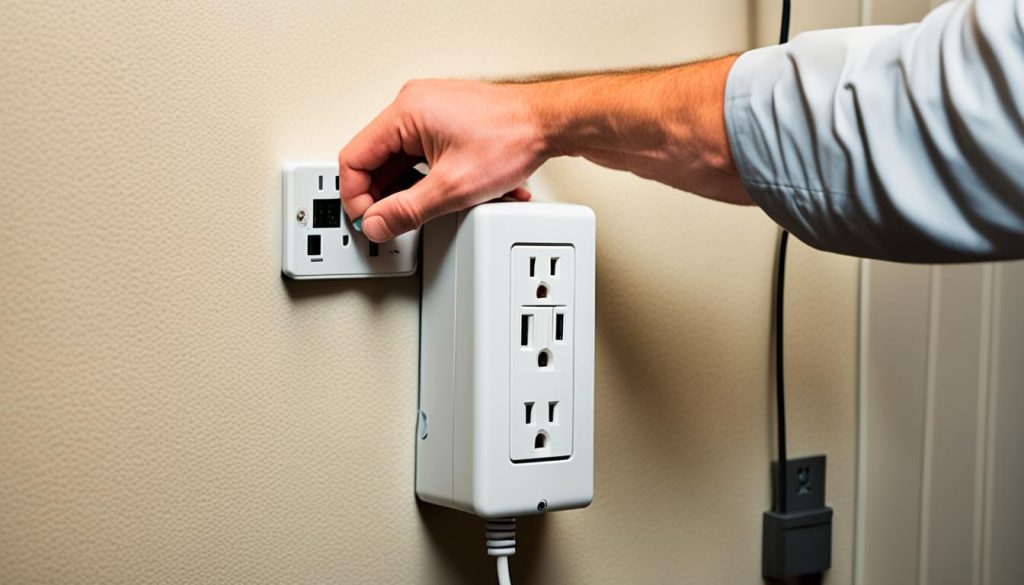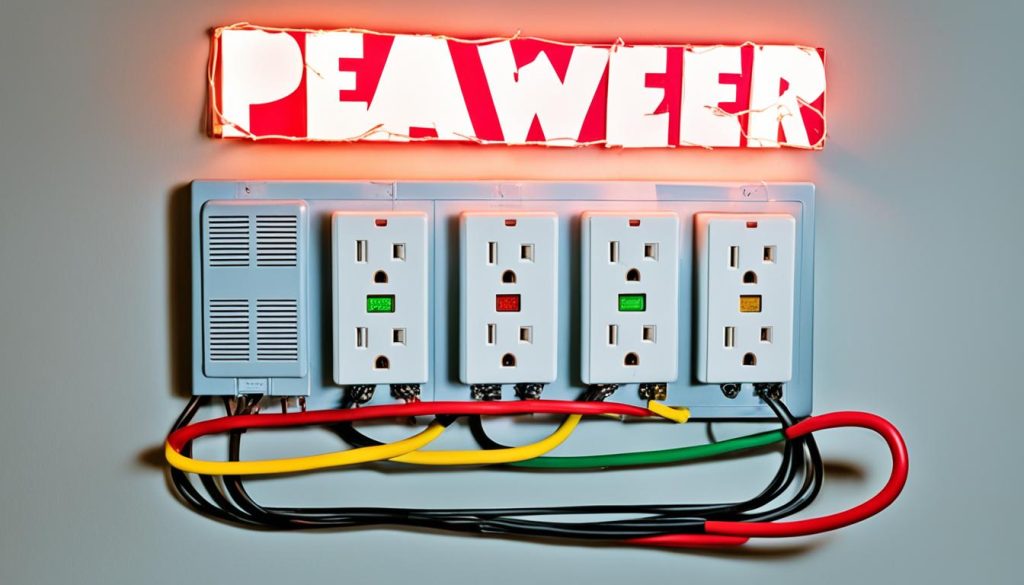Can you plug your air conditioner into a surge protector? It’s a question many homeowners ask, and the answer is crucial for your AC’s performance and your home’s electrical safety. Let’s explore the topic of plugging ACs into surge protectors and determine whether it’s a safe practice or a risky choice.
When it comes to AC power and surge protection, it’s essential to prioritize electrical safety. State Fire Marshal Peter J. Ostroskey advises against plugging air conditioners or other major appliances into surge protectors, extension cords, or power strips. To avoid overloading and potential fire hazards, it’s best to plug these devices directly into wall outlets.
Electrical fires are a significant cause of residential fires in Massachusetts, highlighting the importance of following safety guidelines and utilizing proper electrical connections. To enhance your home’s safety, ensure you have working smoke alarms and a home escape plan in case of a fire.
Key Takeaways:
- Plugging air conditioners into surge protectors, extension cords, or power strips is not recommended for electrical safety.
- Directly plugging ACs into wall outlets helps avoid overloading and potential fire hazards.
- Electrical fires are a significant cause of residential fires in Massachusetts and need to be prevented.
How Surge Protectors Work to Protect Devices
Surge protectors, also known as power strips, are designed to safeguard devices from power surges and voltage fluctuations. They serve as a first line of defense against electrical overload, redirecting excess voltage to the ground and preventing damage to connected appliances and electronics.
During a power surge, the electrical current spikes above the standard voltage level, potentially causing irreparable harm to delicate circuitry. A power surge can occur due to various reasons, including lightning strikes, utility grid fluctuations, or the sudden restoration of power after an outage.
Power surges can have devastating effects on air conditioners, leading to system malfunctions and costly repairs. The sensitive components of an AC, such as circuit boards, compressors, and fan motors, are particularly susceptible to damage.
How Surge Protectors Provide Protection
Surge protectors are equipped with built-in components that detect power surges and divert the excess energy away from your devices. They consist of metal oxide varistors (MOVs) or gas discharge tubes (GDTs), which act as sacrificial elements.
When a power surge occurs, these sacrificial components quickly absorb the excessive voltage, redirecting it to the ground and shielding your devices from harm. This process helps maintain a stable flow of electricity and prevents the voltage from reaching dangerous levels.
A surge protector acts as a gatekeeper, guarding your electronic devices against power surges and electrical overload.
– Electrical Safety Agency
Types of Surge Protectors
There are various types of surge protectors available on the market, each catering to different needs:
- Power Strips: These surge protectors feature multiple outlets and are commonly used to protect everyday electronics.
- Portable Surge Protectors: Designed for on-the-go protection, these compact surge protectors provide defense against power surges while traveling.
- Wall-Mounted Surge Protectors: These surge protectors are installed directly into electrical outlets, offering a permanent and convenient solution for surge protection.
- Whole-House Surge Protectors: Installed at the electrical panel, whole-house surge protectors defend against power surges affecting the entire home.
For air conditioners, it is crucial to use surge protectors specifically designed to handle the power requirements of these appliances. This ensures optimal protection for sensitive AC components.
| Type of Surge Protector | Features |
|---|---|
| Power Strips | Multiple outlets On/off switch Indicator lights |
| Portable Surge Protectors | Compact and lightweight USB charging ports Travel-friendly design |
| Wall-Mounted Surge Protectors | Space-saving installation Flush with the wall Permanent surge protection |
| Whole-House Surge Protectors | Protects entire home Connected to electrical panel Professional installation |
Using a surge protector specifically designed for air conditioners minimizes the risk of electrical damage and extends the lifespan of the AC unit.
As shown in the image above, a surge protector for AC can safeguard the air conditioner from power surges and electrical overload, ensuring reliable performance and enhanced safety.
Factors to Consider When Using a Surge Protector for an AC
When plugging in appliances like air conditioners into a power strip, it is crucial to consider the specific requirements of the system to ensure safety and optimal performance. Small room air conditioners that draw less than 7.5 amps can typically be plugged into regular electrical outlets without issue. However, larger models may require dedicated circuits to handle the higher electrical load. To determine the appropriate setup for your air conditioner, consult the owner’s manual or manufacturer’s guidelines for specific instructions.
When purchasing a surge protector for your AC, there are a few key factors to consider. First and foremost, ensure that the surge protector can handle the wattage of your air conditioner. This information can usually be found in the AC’s specifications or owner’s manual. Additionally, look for surge protectors with built-in circuit breakers. These provide an extra layer of protection by automatically cutting off power in the event of an overload or power surge.
It is important to note that while surge protectors can safeguard your air conditioner from power surges, they also have their limits. To avoid overloading the electrical current, it is generally recommended to limit the number of devices connected to a power strip. This helps ensure that each device receives sufficient power without putting undue strain on the surge protector or the outlet. If you find that you need to connect multiple devices, consider using multiple power strips or seeking alternative solutions, such as utilizing dedicated outlets or installing additional electrical circuits.
By taking these factors into account, you can help protect your air conditioner from power surges and ensure its longevity. Remember to always follow the manufacturer’s guidelines and consult with a professional electrician if you have any concerns or questions about electrical safety.
Surge Protector Selection Guide
| Consideration | Guideline |
|---|---|
| Wattage Rating | Choose a surge protector that can handle the wattage of your air conditioner. |
| Circuit Protection | Look for surge protectors with built-in circuit breakers for added protection. |
| Number of Devices | Limit the number of devices connected to a power strip to avoid overloading the electrical current. |

Hazards of Plugging an AC into a Power Strip
While it is possible to plug an air conditioner into a power strip, doing so comes with several hazards that you need to be aware of. Regular power strips are not designed to handle the energy requirements of air conditioners, which can lead to mechanical damage and the risk of electrical overloads. Incompatible power strips could even permanently damage your equipment or cause electrical fires.
To ensure the safety of your air conditioner and avoid these hazards, it is important to have proper safety measures in place. One of the best ways to protect your air conditioner from electrical overload and power surge is by using surge protectors specifically designed for air conditioners. These surge protectors are equipped to handle the high power demands of air conditioners and provide the necessary protection against electrical overload and power surges.
Limiting the number of devices connected to power strips is also important to prevent overloading the electrical current. Overloading a power strip with multiple high-powered devices can increase the risk of electrical fires and other safety hazards. If you need to connect multiple devices, consider using additional surge protectors or dedicated outlets whenever possible.
In addition to using the right surge protectors and limiting the number of devices, it is crucial to regularly replace your surge protectors. Over time, surge protectors may lose their effectiveness and become less capable of providing reliable protection against electrical overload and power surges. By replacing surge protectors at regular intervals, you can ensure that your air conditioner and other electronics remain safeguarded.
Expert Tip:
“When it comes to plugging your air conditioner into a power strip, it’s crucial to prioritize safety. Use surge protectors designed for air conditioners, limit the number of devices, and regularly replace surge protectors to maintain their effectiveness.”

By being aware of the hazards associated with plugging an air conditioner into a power strip and taking the necessary precautions, you can protect your equipment from electrical overload, power surges, and the risk of electrical fires. Prioritizing safety is crucial to ensure the longevity and reliable operation of your air conditioner.
Best Practices for Protecting AC and Electronics
When it comes to safeguarding your air conditioners and electronics from power surges, following best practices for surge protection is vital. One essential step is to regularly upgrade your surge protectors every two years. By doing so, you can prevent potential electrical damage that could occur with outdated or worn-out surge protectors.
Another crucial aspect is to avoid overloading power strips with high-powered electronics. These power strips have specific load capacities, and exceeding them can lead to power surges and possible damage to your devices. To ensure optimal protection, it’s advisable to distribute high-power devices across multiple outlets or use dedicated outlets whenever possible.
In addition to relying on surge protectors, routine maintenance for your air conditioning systems is equally important. Regular maintenance can help extend their lifespan and ensure efficient operation, reducing the risk of unexpected power surges and electrical issues. To achieve this, consult with HVAC experts and strictly follow the manufacturer’s guidelines.
By adhering to these best practices and implementing proper surge protection measures, you can significantly minimize the risk to both your air conditioners and electronics, providing peace of mind and protecting your valuable investments.
FAQ
Can I plug my air conditioner into a surge protector?
It is generally not safe to plug air conditioners or other major appliances into surge protectors, extension cords, or power strips. These devices should be plugged directly into wall outlets to avoid overloading and potential fire hazards.
How do surge protectors work to protect devices?
Surge protectors redirect excess voltage to the ground, preventing damage to connected appliances and electronics. They are designed to protect devices from power surges and voltage fluctuations, which can result in costly repairs or replacements if exposed to power surges.
What factors should I consider when using a surge protector for my air conditioner?
When using a surge protector for an air conditioner, it is important to consider the specific requirements of the system. Check the owner’s manual or manufacturer’s guidelines for instructions. Make sure the surge protector can handle the wattage of the air conditioner and look for features such as built-in circuit breakers for added protection.
What are the hazards of plugging an air conditioner into a power strip?
Regular power strips may not be designed to handle the energy requirements of air conditioners, leading to the potential for mechanical damage and the risk of electrical overloads. Incompatible power strips could permanently damage the equipment or even cause electrical fires. Experts recommend using surge protectors specifically designed for air conditioners or limiting the number of devices connected to power strips.
What are the best practices for protecting my air conditioner and electronics?
To ensure the safety of air conditioners and electronics, it is crucial to follow best practices for surge protection. Upgrade surge protectors every two years to avoid electrical damage. Avoid overloading power strips with high-powered electronics, and have dedicated outlets for large air conditioning systems when possible. Regular maintenance for air conditioners can also help extend their lifespan and ensure efficient operation.


